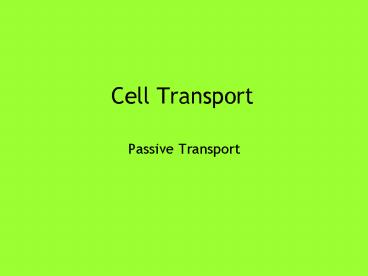Cell Transport PowerPoint PPT Presentation
1 / 22
Title: Cell Transport
1
Cell Transport
- Passive Transport
2
A. Introduction
- 1. When organisms adjust internally to changing
external conditions, this is called homeostasis. - 2. One way cells maintain homeostasis is by
controlling the movement of substances across
their cell membrane. - 3. There are two main types of cell transport
passive transport active transport.
3
B. Passive Transport
- 1. Passive transport movement across the cell
membrane that does NOT require energy - 2. 3 types include diffusion, osmosis, and
protein-aided diffusion
4
- Concentration gradient A difference in the
concentration of a substance across a space. - a. In all forms of passive transport, substances
move from an area of high concentration to an
area of low concentration. - b. This is called moving DOWN the concentration
gradient.
5
- Draw in movement down a concentration gradient
6
I. Diffusion NO energy required!
- a. Diffusion depends on random particle movements
- b. Movement continues until equilibrium occurs
7
- c. Equilibrium a condition in which the
concentration of a substance is equal throughout
a space. - i. Even at equilibrium, particles continue to
move back and forth
8
II. Osmosis NO energy required!
- a. Osmosis refers to the diffusion of water
through a selectively permeable membrane. - b. Water will always move from an area of high
concentration to an area of low concentration. - c. There are 3 types of solutions in osmosis
hypertonic, hypotonic, and isotonic.
9
1. Hypertonic solution water moves out of a
cell, the cell shrinks
- a. The fluid outside the cell has a higher
concentration of dissolved particles thus it has
a lower concentration of free water molecules. - b. There is a higher water concentration inside
the cell
10
- c. Water will move DOWN the concentration
gradient (out of the cell) causing the cell to
shrink. - i. plant cells will go flaccid, plant will wilt
- ii. animal cells will shrink and die if too much
water is lost
11
Elodea in normal water Elodea after adding
salt solution
12
1. Hypotonic solution water moves into of a
cell, the cell swells
- a. The fluid outside the cell has a lower
concentration of dissolved particles thus it has
a higher concentration of free water molecules. - b. There is a lower water concentration inside
the cell
13
- c. Water will move DOWN the concentration
gradient (into of the cell) causing the cell to
swell. - i. plant cells will become turgid due to water
pressing outward against cell wall, helps plant
cells keep their shape (and plant standing
upright!) - ii. animal cells will burst if they take in too
much water
14
- Red blood cells in a hypotonic solution
15
1. Isotonic solution no NET water movement in
or out of cell
- a. The fluid outside the cell has the same
concentration of dissolved particles as inside
the cell. - b. State of equilibrium exists.
16
- c. Water moves in and out of cell at equal rates,
so the cell size stays the same. - i. Animal cells do best in isotonic solutions
- ii. Plants cells will survive but prefer a
hypotonic solution
17
Hypertonic, Isotonic, Hypotonic?
- Isotonic
- Hypotonic
- Hypertonic
18
III. Protein-aided diffusion across membrane
- a. Certain molecules (ions and polar molecules)
cannot pass through the non-polar interior of
cell membrane (i.e. Na, K, Ca2, Cl-) - b. Transport proteins can provide a passageway
for ions polar molecules across the cell
membrane
19
1. Ion Channels
- -Doughnut shaped transport protein with polar
pore through which ions can pass
20
- a. The pores of some ion channels will always be
open Other channels may be closed off by a gate. - b. The opening and closing of the channel gates
may be stimulated by - i. Stretching of the cell membrane
- ii. Change in electrical charge
- iii. Binding of specific molecules
21
2. Facilitated Diffusion
- -Carrier proteins transport substances (amino
acids sugars) down the concentration gradient - a. Specific molecules outside the cell bind to
carrier proteins - b. Carrier protein transports the molecule across
membrane - c. The molecule is released inside, and the
carrier protein reverts back to normal shape
22
C. Rate of Diffusion
- 1. How fast or how slow diffusion occurs depends
on the temperature, size of molecules,
concentration of molecules, and type of molecules
(polor vs. non-polar).

